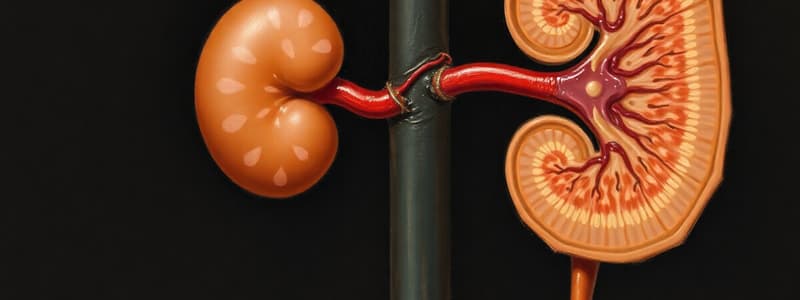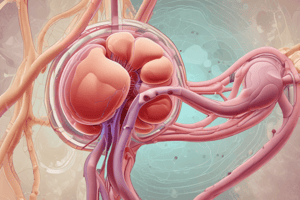Podcast
Questions and Answers
What percentage of urea is reabsorbed in the proximal tubule?
What percentage of urea is reabsorbed in the proximal tubule?
- 50% (correct)
- 75%
- 25%
- 100%
Which factor is directly related to chloride reabsorption?
Which factor is directly related to chloride reabsorption?
- Water reabsorption in the proximal tubule
- Potassium secretion
- Urea concentration in the urine
- Sodium reabsorption (correct)
Where is potassium primarily secreted in the nephron?
Where is potassium primarily secreted in the nephron?
- Glomerulus
- Proximal tubule
- Late distal tubule and collecting duct (correct)
- Ascending limb of the loop of Henle
What mechanism is primarily responsible for H+ secretion in the proximal tubule?
What mechanism is primarily responsible for H+ secretion in the proximal tubule?
Which of the following statements about organic ion secretion in the proximal tubule is correct?
Which of the following statements about organic ion secretion in the proximal tubule is correct?
What is the primary method of transport for sodium ions (Na+) reabsorption in the proximal tubule?
What is the primary method of transport for sodium ions (Na+) reabsorption in the proximal tubule?
What percentage of plasma filtered is typically reabsorbed by the kidneys?
What percentage of plasma filtered is typically reabsorbed by the kidneys?
Which hormone decreases sodium reabsorption in the kidneys?
Which hormone decreases sodium reabsorption in the kidneys?
What is the mode of glucose reabsorption in the proximal tubule?
What is the mode of glucose reabsorption in the proximal tubule?
What characterizes the tubular reabsorption process?
What characterizes the tubular reabsorption process?
Where does no reabsorption of sodium occur in the nephron?
Where does no reabsorption of sodium occur in the nephron?
Which of the following substances is poorly reabsorbed during tubular reabsorption?
Which of the following substances is poorly reabsorbed during tubular reabsorption?
Which statement best describes the mechanism of passive transport during tubular reabsorption?
Which statement best describes the mechanism of passive transport during tubular reabsorption?
What happens when the concentration of glucose in the plasma exceeds the renal threshold?
What happens when the concentration of glucose in the plasma exceeds the renal threshold?
What is the transport maximum (Tm) for glucose in the kidneys?
What is the transport maximum (Tm) for glucose in the kidneys?
Which substance has the highest percentage reabsorbed by the kidneys?
Which substance has the highest percentage reabsorbed by the kidneys?
If the filtered load of glucose is 225 mg/min, what would most likely happen to glucose levels if the renal threshold is exceeded?
If the filtered load of glucose is 225 mg/min, what would most likely happen to glucose levels if the renal threshold is exceeded?
What is the renal plasma threshold concentration for glucose?
What is the renal plasma threshold concentration for glucose?
What defines the term 'filtered load' in relation to kidney function?
What defines the term 'filtered load' in relation to kidney function?
Which of these substances is not reabsorbed by the kidneys?
Which of these substances is not reabsorbed by the kidneys?
What does the term 'splay' refer to in the context of renal physiology?
What does the term 'splay' refer to in the context of renal physiology?
Flashcards
Glucose Reabsorption
Glucose Reabsorption
Nearly all filtered glucose is reabsorbed in the proximal tubule via secondary active transport
Urea Reabsorption
Urea Reabsorption
Approximately 50% of urea is reabsorbed in the proximal tubule; passive process due to concentration gradient
Chloride Reabsorption
Chloride Reabsorption
Chloride passively reabsorbed paracellularly, along with sodium.
Potassium Secretion
Potassium Secretion
Signup and view all the flashcards
H+ Secretion
H+ Secretion
Signup and view all the flashcards
Tubular Reabsorption
Tubular Reabsorption
Signup and view all the flashcards
Na+ Reabsorption
Na+ Reabsorption
Signup and view all the flashcards
Water Reabsorption
Water Reabsorption
Signup and view all the flashcards
Transport Maximum (Tm)
Transport Maximum (Tm)
Signup and view all the flashcards
Renal Plasma Threshold
Renal Plasma Threshold
Signup and view all the flashcards
Tubular Secretion
Tubular Secretion
Signup and view all the flashcards
Proximal Tubule (PT)
Proximal Tubule (PT)
Signup and view all the flashcards
Renal Threshold
Renal Threshold
Signup and view all the flashcards
Filtered Load
Filtered Load
Signup and view all the flashcards
Glucose Renal Threshold
Glucose Renal Threshold
Signup and view all the flashcards
Tm for Glucose
Tm for Glucose
Signup and view all the flashcards
Study Notes
Renal Function: Tubular Processing
- Renal function involves tubular processing of the glomerular filtrate, including reabsorption and secretion.
Learning Objectives
- Define renal processes: Tubular reabsorption and tubular secretion.
- Describe the mode of reabsorption of various substances (e.g., Na+, K+, Cl-, glucose, urea, and water).
- Describe the mode of secretion of various substances (e.g., K+, H+, and organic ions).
- Define transport maximum (Tm), renal plasma threshold, and splay.
Basic Renal Processes
- Renal processes involve filtration, reabsorption, and secretion.
- Excretion = Filtration - Reabsorption + Secretion
Tubular Reabsorption
- Definition: Highly selective and quantitatively large, reabsorbing 178.5 liters of the 180 liters of plasma filtered daily.
- Nutritional substances are completely reabsorbed, while waste products are poorly reabsorbed.
- Many plasma electrolytes are reabsorbed based on body needs.
Tubule Structure
- Tubules are single-layered, close to peritubular capillaries.
- Tubule cells are connected by tight junctions.
Cell Transport
- Passive transport: No energy required, occurs down electrochemical or osmotic gradients.
- Active transport: Requires energy, occurs against electrochemical or osmotic gradients.
- Primary active transport
- Secondary active transport
- Cotransport
- Countertransport
Types of Transport
- Uniport: Transports one substance in one direction.
- Symport: Transports two different substances in the same direction.
- Antiport: Transports two different substances in opposite directions.
Tubular Reabsorption Mechanism
- Process: Involves both paracellular and transcellular pathways.
- Bulk flow, active transport (ATP), passive transport (diffusion), and osmosis are involved
Sodium Reabsorption
- Primarily by primary active transport (Na+-K+-ATPase).
- Reabsorption varies across different parts of the renal tubule.
- 65% is reabsorbed in the proximal tubule (PT) and subject to hormonal control in distal parts.
- 25% is reabsorbed in the loop of Henle (ALOH)
- 8% of distal portions of the nephrons are subject to hormonal control by Aldosterone and Atrial natriuretic peptide (ANP).
Water Reabsorption
- Passive transport (osmosis) coupled to Na+ reabsorption.
- 65% is reabsorbed in PT (Aquaporins always open).
- 15% in the loop of Henle (DLOH).
- 20% in distal portions under Antidiuretic Hormone (ADH) control, dependent on body hydration.
Glucose and Amino Acid Reabsorption
- 100% reabsorbed in the PT via Na+ dependent secondary active transport (cotransport).
Chloride and Urea Reabsorption
- Urea: 50% reabsorbed in the PT; passively reabsorbed down its conc. gradient.
- Chloride: Reabsorbed passively, alongside Na+ reabsorption.
Urea Reabsorption
- Urea is filtered out, partially reabsorbed by passive diffusion.
- Reabsorption is driven by tubular water's concentration gradient.
Chloride and Urea Reabsorption
- Na+ and water reabsorption influence Chloride and urea reabsorption.
Sodium, Chloride, and Potassium Transport in the TALH
- The loop of Henle has a critical transport role. Transport mechanisms involve active transport of sodium and chlorine.
Potassium Reabsorption
- 65% reabsorbed paracellularly in the proximal tubule.
- 20% reabsorbed in the loop of Henle.
- Movement in distal tubule and collecting duct depends on body needs.
Tubular Secretion
- Active process removing substances like K+, H+ and organic ions.
Potassium Secretion
- Potassium reabsorbed paracellularly in the PT.
- Potassium secreted by principal cells in late distal and collecting tubules.
- Influenced by plasma potassium levels and aldosterone.
H+ Secretion
- A critical part of acid-base balance.
- It occurs in the proximal tubule via Na+-H+ counter transport (secondary active transport).
- In the distal and collecting tubules through H+-ATPase (primary active transport).
Organic Ions Secretion
- Two carrier types in PT for organic anions and cations.
- Non-selective pathway for excretion of many drugs and other substances.
Filtration Load
- Filtered load describes the amount of a substance filtered into Bowman's space per unit time.
- Formula: Filtered load = plasma concentration X GFR
Transport Maximum (Tm)
- Tm is a theoretical maximum transport limit for substances actively transported by the tubules.
- Tm is saturated at higher concentration.
- There's a limit to the transport rate due to transporter saturation.
- The Tm for glucose is ~375 mg/minute.
Renal Threshold
- The renal threshold is the plasma concentration at which a substance starts appearing in the urine.
- The glucose threshold is ~180 mg/100 ml.
Different Kinds of Diuretics
- Various diuretics influence specific transport mechanisms in the nephron. They inhibit reabsorption of Na+, K+, Cl-, water, or other materials along the tubules.
Summary
- Defines tubular reabsorption and secretion.
- Outlines different transport modes across the epithelium.
- Describes reabsorption modes for Na+, H2O, Cl–, glucose, urea, and potassium.
- Identifies important tubule-secreted substances.
- Defines transport maximum, renal plasma threshold, and splay.
Studying That Suits You
Use AI to generate personalized quizzes and flashcards to suit your learning preferences.



